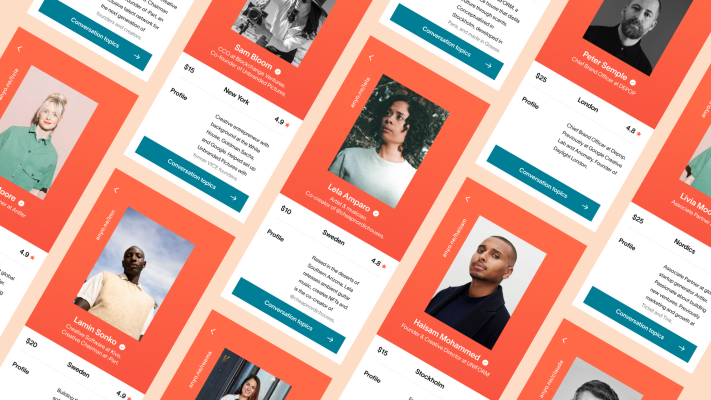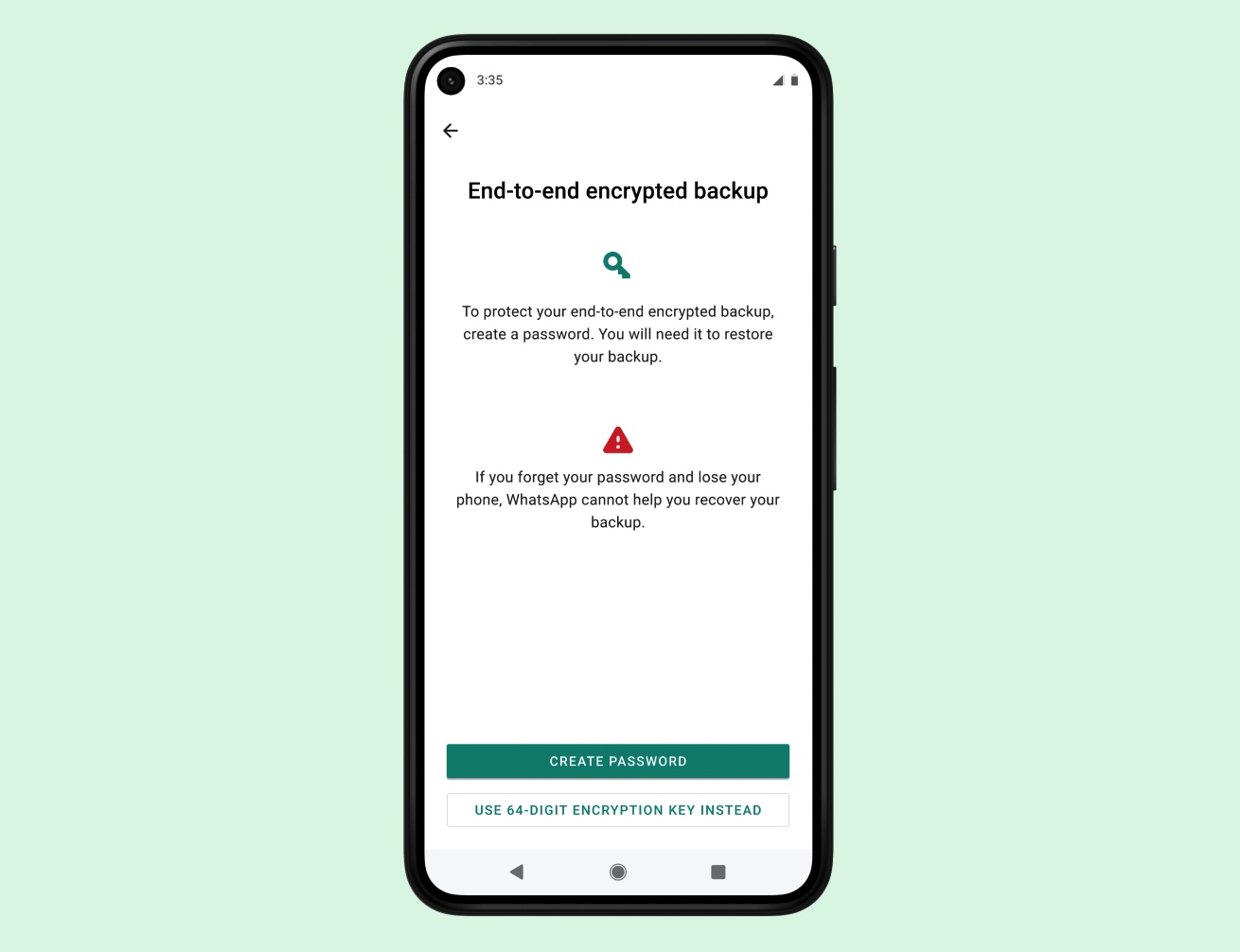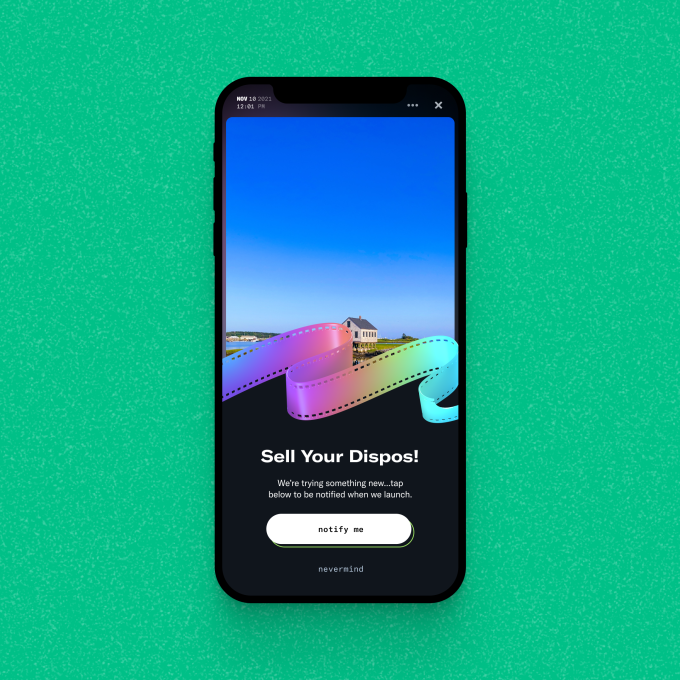APPS
Anyone is building a marketplace for advice, one 5-minute call at a time


Anyone, an audio app that’s building a “marketplace for advice” one five-minute phone call at a time, is launching new versions of its iOS and Android apps today* and beginning large-scale onboarding after operating in a limited closed beta for the past six months.
The app — which was founded around 18 months ago (so pre-pandemic) — has a simple premise: Advice is best delivered verbally, concisely and one-to-one, in a time-limited format.
Video is distracting and a hassle to fit into busy people’s schedules. Text is time-consuming and prone to misunderstandings. But a simple phone call can — quickly and usefully — cut through, is the thinking here.
Hence the decision to hard stop at a five-minute phone call. The app automatically terminates each call at the five minute mark — no ifs, no buts (and, well, hopefully fewer time-nibbling “ums” and “ahs” too).
To fund development of the marketplace, the team has raised around $4 million in total to date — mainly comprising a $3.6 million seed round led by Berlin-based Cavalry Ventures with participation from Supernode Global, Antler and a number of high-profile angel investors (contributing angels include Atomico’s Sarah Drinkwater and Sameer Singh; and ustwo’s Matt “Mills” Miller, among others).
Broadly speaking, online audio has shown its staying power through a sustained podcast boom and, more recently, a buzzy moment for social audio, via developments like Clubhouse and Twitter Spaces — which speak to a general sense of pandemic-struck “Zoom fatigue” as remote workers max out on video calls at work yet still crave meaningful connections with other people at a time when opportunities to mingle in person are still limited versus pre-COVID-19.
A lot of social audio can still be very noisy, though, and Anyone wants to be anything but. This is short-form, topic-specific audio.
Why five minutes? It’s short enough for a busy person to almost not have to think twice about taking a cold call from someone they’ve probably never spoken to before — while being just about long enough that some useful advice can be distilled and imparted across those 300 seconds of one-to-one connection.
Naturally the short format does not allow for group/conference calls. It’s one-to-one only.
Anyone’s CEO also reckons this “intimate,” short-form audio format could help drive diversity of advice by encouraging people whose voices may be underrepresented in traditional mentorship to feel more comfortable offering their time and knowledge to others. (He touts a current 50:50 user-split between men and women offering expertise through the app — and 25% people of color.)
“It’s not about taking long-form meetings and compressing them — it’s about taking those conversations that would never have happened … and making them happen,” says CEO and co-founder David Orlic, pointing out that mainstream calendar apps have a default meeting slot that’s set to half an hour or an hour. So the wider thesis is that our current tools/infrastructure just aren’t set up to help people give and grab bitesized advice. (And, well, on the internet anyone can claim to be an expert — but of course you can’t rely on the quality of the “advice” you find freely floating around online.)
“Our belief is that there are a lot of five minute problems that we could be solving — whereas there are a lot of 30 or 60 minute problems that have solutions designed for them already. So we’re kind of building this for those conversations that aren’t happening,” he adds.
Orlic hints that the intention is also to leave Anyone’s callers a little hungry for more — to feed demand for more five-minute conversations and so fuel transactions across the marketplace.
“If you look at the demand side — the callers — there’s always multiple calls involved. So people will call a lot of people and ask them basically the same question or bounce ideas. And then they will aggregate those insights into something that’s much more valuable than one conversation,” he continues. “So it’s like building an advisory board for yourself.”
The idea for the platform came after Orlic and his co-founders realized they could trace key career decisions to a handful of short conversations — brief moments of advice that ended up profoundly influencing the trajectory of their working lives, to the point where they were still looking back on them years later.
“None of us in the founding team had any networks to speak of when we were growing up. And we had fairly little exposure to opportunity. Alfred is from a small village in the middle of nowhere in Sweden, I grew up in an immigrant family, and Sam is a working class bloke from Leeds. And looking back at our careers we could track them back to this handful of conversations — these haphazard moments when someone gave us a piece of critical advice,” he tells TechCrunch. “For them it was just another five minute chat but for us it turned out to be life-changing.”
“For Alfred it was some quick advice on how he could land a job at Google which he managed to do and spent almost a decade there working as a growth guy on Google Chrome and other stuff; for Sam it was how to start a company; for me it was the suggestion that I as a creative should pursue an MBA — which I ended up doing. So we started thinking long and hard about the concept of advice, and we became obsessed with opening up these closed networks.”
The aim for Anyone’s marketplace is to make similarly pivotal moments accessible to all sorts of people — by giving the app’s users the chance to call any expertise provider on the network (provided they can afford the fee) and ask their question.
A slogan on its website poses the question “imagine if you could call anyone in the world” — which is certainly a poetic-sounding moonshot to be shooting for, although the size of the user base remains far off that global vision at this early stage.
“What we’re building is really the phone book of the future,” says Orlic, slotting his elevator pitch into our ~30-minute phone conversation. “We’re building a place for unique, one-to-one, five minute experiences — which is something really different from most social audio plays.”
He points to a trend of other apps intentionally applying limits to change/define the user experience in behavior-shaping ways (like Poparazzi, a self-styled “anti-Instagram” photo-sharing app that doesn’t let you take selfies to make you take more pics of your friends and vice versa; or the dating app Thursday, which limits users to one active day of use per week to prevent endless swiping and nudge matches toward going on an actual in-person date).
The marketplace component of Anyone’s app is another intentional limit too, of course. Calls are not free by default.
Putting a price on Anyone’s one-to-one advice is one way to try to weed out unserious (or indeed abusive) users from those genuinely seeking others’ expertise on specific topics.
But primarily it’s there to provide an incentivize for people who have expertise worth sharing to make themselves available to take cold calls (even very short ones) from strangers/those outside their existing contact networks.
Pricing for a five-minute call is set by Anyone users. So the call fee can vary from nothing at all (if the user distributes a free voucher code) to as little as $5 or all the way up to $500 (!), which does sound pretty crazy expensive. But Orlic notes users can choose to donate their fee to a charity if they do not wish to financially benefit from the advice they’re dishing out (so there may be instances where a high fee includes a philanthropic component).
With such highly variable fees, the app will need to have a good safety mechanism to reconfirm a user really does want to be charged the specific fee. (And, god forbid, to avoid the risk of butt-dialling … 😬)
“If you want to connect with someone I think it’s reasonable to put a cost on the scarcest resource on the planet which is someone’s undivided attention,” Orlic argues, suggesting that plenty of mainstream tech confuses transient “access” with attention. “We can ‘access’ people everywhere — we can listen to them, read them, follow them. But that’s not the same as attention … Someone’s undivided attention is a remarkable, remarkable thing. And the five-minute cap forces you to be very clear and to the point about what you want to chat about.”
With its intentionally attention-slicing infrastructure — which manages ephemeral contacts into precisely measured and billed units — “all of a sudden you have all of these conversations that wouldn’t have happened happening thanks to this manageable way of connecting with people,” is the claim.
Anyone users wanting to list themselves on the marketplace to sell one-to-one advice will need to create a profile that specifies their availability to take calls and some basic details (name, career details, location, etc.), as well as setting their five minute fee.
They also need to provide details of the “conversation topics” they’re comfortable giving advice on.
Co-founder Alfred Malmros’ profile includes examples such as: “Make the leap. Quitting a dream job to make it on your own”; “Rising quickly in a large organisation — politics vs. talent”; and “It takes a fool to remain sane. Thriving as an employee” — so topic steerage looks intended to be not only specific but maybe also give a flavor of the individual’s personality to further help advice-seekers decide if they want to shell out for five minutes of that particular person’s time.
The risk of imposters or low-quality advice is being managed by “vetting and verification” processing all advisers have to go through prior to being able to sell, per Orlic. “Beyond verification, we put a lot of work into making sure that everyone on Anyone understands what constitutes good advice, how to avoid projection and biases in conversations, etc.,” he adds.
The platform also incorporates a rating system — again, in an attempt to keep quality up across the marketplace.
Anyone’s early users are a blend of creators, founders and investors, per Orlic — including a lot of first- and second-time founders, as you might expect, with the pandemic having limited in-person startup networking opportunities.
He also says they’ve attracted a lot of people midcareer, looking for advice on how to quit their jobs and pivot into something totally new — again, likely fuelled by the pandemic reconfiguring many things around how we work (and, more broadly, how we may be thinking about work-life balance).
“When you’re doing that kind of big life decision you really want to connect with a lot of people and ask around,” he suggests on the interest from established professionals looking for advice on a career switch. “Also there’s a high willingness to pay, I’d argue, when you’re in that position.”
“Business is a huge thing as a marketplace for advice,” Orlic adds, noting that a record number of businesses started in the last year too. “Investors — by the way — love this for deal flow because they can speed date a lot of founders and then pick who they continue with.”
Parents are another community of early users he highlights — saying they’ve been both offering and soliciting advice during the early test phase. He says one of the best pieces of advice he’s personally gained through the network was a conversation about parenting, adding: “I’ve had some really profound conversations with other dads. People that know a lot more about parenting than I do — where I’ve gotten really actionable advice and support. So that has been a big thing for me personally.”
Orlic also says he’s excited about potential in the area of mental health — suggesting the short-form format could be helpful to get people to have conversations about therapy which, since they’re so bitesized and bounded, may be a non-intimidating introduction toward taking up more sustained support.
He also mentions that he’s excited about the potential for civic society to make use of the platform as a tool for driving public engagement and awareness around issues and campaigns.
Appropriately enough, Anyone’s team has been dogfooding by using the app to get advice to help build the startup. Orlic admits he asked someone on the network how to get TechCrunch’s attention and was advised, by the unnamed investor, to pitch this reporter — so it sounds like he got some solid advice there 😉
The app has had around 1,000 test users during the closed beta period — with some 12,000 on the waitlist that Orlic says they’ll be onboarding over the coming weeks.
Network building — so growing the size of the user base on both the expertise and demand sides — is clearly going to be a key challenge here. (And notably Orlic emphases the network effects expertise of its angel backer, Singh.)
Anyone’s five-minute format may be bitesize enough to encourage users to spread the word of any good experiences they have on the platform to their (wider) social graphs on mainstream social networks. Although the calls themselves must surely remain private between the two interlocutors — so there are some hard limits on the app content being able to go viral.
(At the time of writing, a link to Anyone’s privacy policy wasn’t working so we asked for a confirm on the privacy of calls — and Orlic told us: “All calls on the new app are completely e2e encrypted, and there’s no way to listen in on an ongoing conversation. For user safety, calls are recorded, anonymised and stored in a secure environment for maximum 30 days. So in case a user reports a specific call in the app and wants a refund, or if an adviser flags up harassment or other serious issues, we can deal with that in a sustainable way.”)
At the same time it’s not hard to imagine a platform like Twitter (or, indeed, LinkedIn) seeing value in offering a similar one-to-one user call capability — and bolting it on as a feature on an established network where users have already built up extensive social graphs. So If Anyone’s idea really takes off the risk of cloning could get very real — which means it will have to balance network building/growth with attention to the quality of the community it’s building and innovating to keep its users happily stuck to its own (inevitably smaller) network.
Commenting on backing the app in a statement, Claude Ritter, managing partner at Cavalry Ventures, said: “What sets Anyone apart from other audio apps is the quality and connection of 1:1 advice. The team saw the potential of audio and the emergence of the creator economy long before the hype. We’re impressed by what they’ve accomplished to date and by their mission to build the phone book of the future.”
Around 9,000 five-minute calls have been made via Anyone’s platform so far, per Orlic — who says the goal they’re shooting for as they open up access now is to get to 100,000 calls within a year.
The business model for now is to take a straightforward 20% cut of the advice fee.
On the fee side there’s also potential for things to get bumpy if momentum builds around the concept — given that platform giants have been known to take a predatory approach to pricing when trying to close down creator-supporting upstart competition via their own fast-following clones. (See, for example, Facebook’s recent dive into offering a newsletter platform — for which it’s both paying writers upfront for contributions and, at least initially, not taking any cut of their subscriptions.)
It’s clear that Anyone will need to pay particular attention to the quality of the advice and community it’s building. It may even end up needing to hone in on serving particular niches and specialisms in order to leverage differentiation versus larger, more generalist networks that have the advantage of larger user bases should they decide to move in on the same “quick call” turf.
At the same time, there are signs that some of the buzz around social audio may be fading away to more of a hmm as the hype dies down and app users tire of all the noise. But again, that’s why Anyone keeping the audio side intentionally short looks smart.
“We feel that we are part of a movement that is rebuilding the internet as we know it and building something that is more sustainable and healthy — and really creating value,” says Orlic, discussing the changing landscape around social apps. “Closed social is a topic that I’m really excited by. We’ve seen this for years, with Slack channels and WhatsApp groups. We’ve seen social closing off because of a tonne of different reasons — and with Geneva and a lot of new really cool startups and platforms we’re seeing everything focus around communities. People building communities around specific verticals and then monetizing them in different ways. So we’re definitely a part of that wave.
“A lot of our most active users are people who have built audiences around specific topics and want more meaningful connections with those audiences — the Substack writers that use us as a way to both connect with their existing readers but also gaining new superfans, if you will, because when you’ve had a five minute chat with someone and then sign up to read their Substack, you will read everything they write after that kind of intro. So we’re definitely a part of that closed social. But as a business we are a marketplace — because again we’re obsessed with that idea of someone’s undivided attention being a very scarce resource and the fact that we’re seeing the ‘Cameo-ification’ of everything and everyone. And that is also here to stay.”
“Monetization — in one way — sounds like a really crass and cynical concept but at the end of the day we want people to build income streams around things they’re passionate and know a lot about. At the end of the day that is a wonderful, wonderful thing,” he adds. “A creator middle class is a very exciting concept because looking at all the big platforms, old social media, we know where the money is going — it’s going to the top 0.1% of influencers and creators. Whereas small and midtier creators are not making money to sustain themselves off their passion. For that you have all of these cohort-based courses through Maven. And platforms like us — that enable people to connect directly with each other in a one-to-one setting.
“We think it’s very cool that we’re doing an opinionated, one-to-one, five-minute, audio-only platform because that gives us a unique positioning. And this is what excites the team. Seeing these stories come out of it — and those stories would not come out of it if it was just another broadcasting or Clubhouse thing.”
There is of course no small irony that it’s exactly because of the proliferation of mobile connectivity and apps — which have driven increased utility by providing people with on-demand access to so much data (and people) — that the traditional ‘quick call’ of old has been derailed, creating conditions where a startup feels there’s an opportunity to build a dedicated marketplace for scheduled quick phone calls. (Albeit, one that’s aiming to scale to a far wider network that the average person would have had in their phone book back in the 1980s, say.)
But as software and connectivity keeps eating the world, enforcing tech upgrades and reconfiguring learned behaviors, it’s clear that the resulting disruption can recreate the right conditions for new tools to come in and repackage some of the old convenience — which maybe got a bit lost in the noise.
*App Store review gods willing
APPS
Best ASO Tips To Boost Your App Search In 2022

You need your application to be really effective in the overpopulated application market. Then, at that point, you will have to drive downloads to endure. So when it’s all said and done, you must account for yourself. Get your application the consideration it merits.
The uplifting news, however, is that customers love to download applications – last year, we downloaded in excess of 200 billion applications around the world, and that figure is set to increment to 258 billion every year by 2022 as cell phone reception increments.
Assuming you need to be seen and have your application downloaded by however many clients as could reasonably be expected, then, at that point, you should begin by taking a gander at the application store.
Underneath, we’ve assembled probably the best application store improvement methods to assist you with creating more downloads in 2021 and then some…
Start with Your Application Name
The odds are you as of now have an extraordinary name for your application, yet an appropriately advanced application is about significantly more than marking.
Assuming you need to amplify transparency and guarantee you’re showing up when clients look for applications like yours, you ought to remember the primary keywords for your application name or title, comparable to how you’d make a title label while improving a site page.
You could begin with your application name so it tends to be plainly recognized, thus it appears on the home screen of gadgets.
Then, at that point, you can add a scramble or vertical bar prior to adding a few pertinent watchwords to your speciality, or even put your application name in quotes as we did with FORE Business Golf Networking.
Urge Users to Leave Reviews
You could ask for reviews by clients through the means of your site, or through an in-application notice toward the finish of their meeting, yet make sure to restrict the number of pop-ups you execute with the goal that you don’t disturb or disappoint your clients, as this could urge them to erase your application.
We’d support all application engineers and entrepreneurs to react to criticism on their applications, as this can further develop client relations and resolve issues in an open arena.
Zero in on Your Application Depiction
Your application depiction is your principle assemblage of text your landing page content, in a manner of speaking. Utilize a site like KeywordTool.io to discover information on your picked catchphrases to expand your openness. As portrayals are shortened, ensure you remember the main data for the initial three lines of your depiction, and afterwards add things like social confirmation, emoticon, and suggestions to take action to build commitment and downloads.
Incorporate Appealings Screen Captures
Pictures and recordings won’t help your application rank, yet they will expand changes and assist clients with working out whether it’s an application they truly need.
There’s a little guide in empowering clients toward downloading your application if in any case, they’re not going to interface with it, or download and leave a negative survey when they understand it wasn’t what was promoted.
Assuming you need to ‘tart up’ your item page, then, at that point, you can add marking and extra text and data and designs to your recordings and screen capture, yet they ought not to diminish your item.
Pay for App Store or Play Store
As we have SEO and pay-per-click, you need to work one next to the other (one is a gradual methodology with long haul benefits – the other is a speedy success yet requires an endless spending plan), application store promotions can be utilized to get the message out with regards to your new programming and assist you with positioning at the highest point of query items pages – in front of your opposition and enormous names in the application world.
Keep in mind, you’ll need to focus on the right crowd and art an advertisement that will assist you with changing over and that since you’re paying for situations, that doesn’t mean clients will download or cooperate with your application.
Wrapping Up!
You can employ a group of App Store Optimization Services suppliers to benefit a scope of application store improvement administrations, including watchword advancement, resource enhancement, and restriction to guarantee your application is seen by individuals that matter.
We have long periods of involvement in creating and showcasing applications and have assisted different customers with expanding their downloads by infiltrating rewarding and regularly undiscovered business sectors.
Author:
Prachi Gupta likes to write information about Digital Marketing Trends that can help audience to grow their business.
APPS
WhatsApp will finally let users encrypt their chat backups in the cloud

WhatsApp said on Friday it will give its two billion users the option to encrypt their chat backups to the cloud, taking a significant step to put a lid on one of the tricky ways private communication between individuals on the app can be compromised.
The Facebook-owned service has end-to-end encrypted chats between users for more than a decade. But users have had no option but to store their chat backup to their cloud — iCloud on iPhones and Google Drive on Android — in an unencrypted format.
Tapping these unencrypted WhatsApp chat backups on Google and Apple servers is one of the widely known ways law enforcement agencies across the globe have for years been able to access WhatsApp chats of suspect individuals.
Now WhatsApp says it is patching this weak link in the system.
“WhatsApp is the first global messaging service at this scale to offer end-to-end encrypted messaging and backups, and getting there was a really hard technical challenge that required an entirely new framework for key storage and cloud storage across operating systems,” said Facebook’s chief executive Mark Zuckerberg in a post announcing the new feature.
Store your own encryption keys
The company said it has devised a system to enable WhatsApp users on Android and iOS to lock their chat backups with encryption keys. WhatsApp says it will offer users two ways to encrypt their cloud backups, and the feature is optional.
In the “coming weeks,” users on WhatsApp will see an option to generate a 64-digit encryption key to lock their chat backups in the cloud. Users can store the encryption key offline or in a password manager of their choice, or they can create a password that backs up their encryption key in a cloud-based “backup key vault” that WhatsApp has developed. The cloud-stored encryption key can’t be used without the user’s password, which isn’t known by WhatsApp.

Image Credits: WhatsApp/supplied
“We know that some will prefer the 64-digit encryption key whereas others want something they can easily remember, so we will be including both options. Once a user sets their backup password, it is not known to us. They can reset it on their original device if they forget it,” WhatsApp said.
“For the 64-digit key, we will notify users multiple times when they sign up for end-to-end encrypted backups that if they lose their 64-digit key, we will not be able to restore their backup and that they should write it down. Before the setup is complete, we’ll ask users to affirm that they’ve saved their password or 64-digit encryption key.”
A WhatsApp spokesperson told TechCrunch that once an encrypted backup is created, previous copies of the backup will be deleted. “This will happen automatically and there is no action that a user will need to take,” the spokesperson added.
Potential regulatory pushback?
The move to introduce this added layer of privacy is significant and one that could have far-reaching implications.
End-to-end encryption remains a thorny topic of discussion as governments continue to lobby for backdoors. Apple was reportedly pressured to not add encryption to iCloud Backups after the FBI complained, and while Google has offered users the ability to encrypt their data stored in Google Drive, the company allegedly didn’t tell governments before it rolled out the feature.
When asked by TechCrunch whether WhatsApp, or its parent firm Facebook, had consulted with government bodies — or if it had received their support — during the development process of this feature, the company declined to discuss any such conversations.
“People’s messages are deeply personal and as we live more of our lives online, we believe companies should enhance the security they provide their users. By releasing this feature, we are providing our users with the option to add this additional layer of security for their backups if they’d like to, and we’re excited to give our users a meaningful advancement in the safety of their personal messages,” the company told TechCrunch.
WhatsApp also confirmed that it will be rolling out this optional feature in every market where its app is operational. It’s not uncommon for companies to withhold privacy features for legal and regulatory reasons. Apple’s upcoming encrypted browsing feature, for instance, won’t be made available to users in certain authoritarian regimes, such as China, Belarus, Egypt, Kazakhstan, Saudi Arabia, Turkmenistan, Uganda and the Philippines.
At any rate, Friday’s announcement comes days after ProPublica reported that private end-to-end encrypted conversations between two users can be read by human contractors when messages are reported by users.
“Making backups fully encrypted is really hard and it’s particularly hard to make it reliable and simple enough for people to use. No other messaging service at this scale has done this and provided this level of security for people’s messages,” Uzma Barlaskar, product lead for privacy at WhatsApp, told TechCrunch.
“We’ve been working on this problem for many years, and to build this, we had to develop an entirely new framework for key storage and cloud storage that can be used across the world’s largest operating systems and that took time.”
APPS
Dispo launches a test to gauge user interest in selling their photos as NFTs

Dispo, the photo-sharing app that emulates disposable cameras, started rolling out a test yesterday that will record user interest in selling photos as NFTs. Some users will now see a sell button on their photos, and when they tap it, they can sign up to be notified when the ability to sell Dispo photos launches.
CEO and co-founder Daniel Liss told TechCrunch that Dispo is still deciding how it will incorporate NFT sales into the app, which is why the platform is piloting a test with its users. Dispo doesn’t know yet what blockchain it would use, if it would partner with an NFT marketplace or what cut of sales Dispo would take.
“I think it’s safe to say from the test that there will be an experience native to the Dispo app,” Liss said. “There are a number of ways it could look — there could be a native experience within Dispo that then connects through an API to another platform, and in turn, they’re our partner, but to the community, it would look native to the Dispo app.”

Image Credits: Dispo
This marks a new direction for the social media app, which seeks to redefine the photo-sharing experience by only letting users see the photos they took at 9 AM the next morning. From Dispo’s perspective, this gimmick helps users share more authentically, since you take one photo and then you’re done — the app isn’t conducive to taking dozens of selfies and posting the “best” image of yourself. But though it only launched in December 2019, Dispo has already faced both buzzy hype and devastating controversy.
Until about a year ago, the app was called David’s Disposables, named after co-founder and YouTuber David Dobrik. The app was downloaded over a million times in the first week after its release and hit No. 1 on the App Store charts. In March 2021, the app dropped its waitlist and relaunched with social network features, but just weeks later, Insider reported sexual assault allegations against a member of Vlog Squad, Dobrik’s YouTube prank ensemble. In response, Spark Capital severed ties with the company, leading to Dobrik’s departure. Other investors like Seven Seven Six and Unshackled Ventures, which contributed to the company’s $20 million Series A round, announced that they would donate any profits from their investments in Dispo to organizations working with survivors of sexual assault.
Liss told TechCrunch in June, when the company confirmed its Series A, that Dobrik’s role with the company was as a marketing partner — Liss has been CEO since the beginning. In light of the controversy, Liss said the app focused on improving the product itself and took a step back from promotion.
According to data from the app analytics firm SensorTower, Dispo has reached an estimated 4.7 million global installs to date since launch. Though the app saw the most downloads in January 2020, when it was installed over 1 million times, the app’s next best month came in March 2021, when it removed its waitlist — that month, about 616,000 people downloaded Dispo. Between March and the end of August, the app was downloaded around 1.4 million times, which is up 118% year over year compared to the same time frame in 2020 — but it should be expected that this year’s numbers would be higher, since last year, the app’s membership was exclusive.

Image Credits: Dispo
Now, with the announcement that Dispo is pursuing NFTs, Liss hopes that his company won’t just change how people post photos, but what the relationship will be between platforms and the content that users create.
“Why NFTs? The most powerful memories of our lives have value. And they have economic value, because we created them, and the past of social media fails to recognize that,” Liss told TechCrunch. “As a result, the only way that a creator with a big following is compensated is by selling directly to a brand, as opposed to profiting from the content itself.”
Adding NFT sales to the app offers Dispo a way to profit from a cut of user sales, but it stands to question how adding NFT sales could impact the community-focused feel of Dispo.
“I think there is tremendous curiosity and interest,” Liss said. “But these problems and questions are why we need more data.”
-

 PPC4 days ago
PPC4 days ago19 Best SEO Tools in 2024 (For Every Use Case)
-

 PPC7 days ago
PPC7 days ago4 New Google Ads Performance Max Updates: What You Need to Know
-

 MARKETING7 days ago
MARKETING7 days agoWill Google Buy HubSpot? | Content Marketing Institute
-
SEARCHENGINES6 days ago
Daily Search Forum Recap: April 16, 2024
-

 SEO6 days ago
SEO6 days agoGoogle Clarifies Vacation Rental Structured Data
-

 MARKETING6 days ago
MARKETING6 days agoStreamlining Processes for Increased Efficiency and Results
-
SEARCHENGINES5 days ago
Daily Search Forum Recap: April 17, 2024
-

 PPC7 days ago
PPC7 days agoHow to Collect & Use Customer Data the Right (& Ethical) Way















